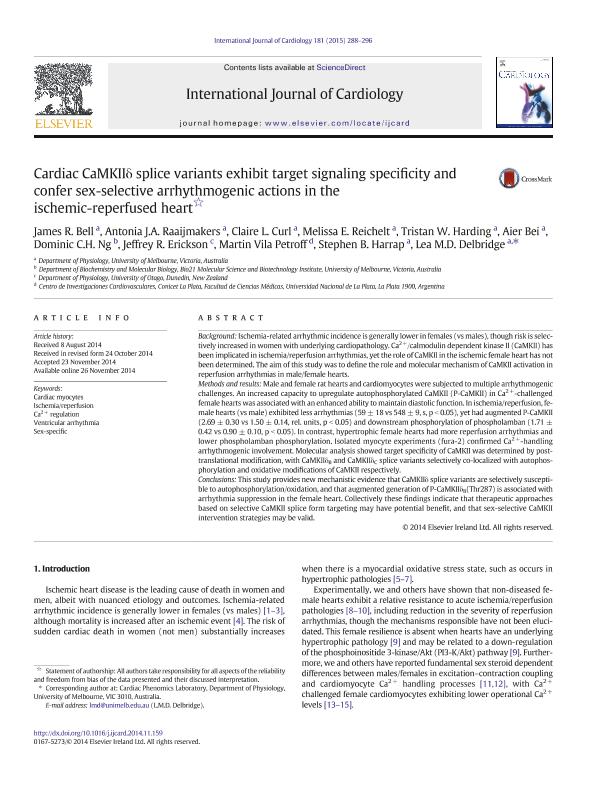Artículo
Cardiac CaMKIIδ splice variants exhibit target signaling specificity and confer sex-selective arrhythmogenic actions in the ischemic-reperfused heart
Bell, James R.; Raaijmakers, Antonia J.A.; Curl, Claire L.; Reichelt, Melissa E.; Harding, Tristan W.; Bei, Aier; Ng, Dominic C.H.; Erickson, Jeffrey R.; Vila Petroff, Martin Gerarde ; Harrap, Stephen B.; Delbridge, Lea M.D.
; Harrap, Stephen B.; Delbridge, Lea M.D.
 ; Harrap, Stephen B.; Delbridge, Lea M.D.
; Harrap, Stephen B.; Delbridge, Lea M.D.
Fecha de publicación:
02/2015
Editorial:
Elsevier Ireland
Revista:
International Journal Of Cardiology
ISSN:
0167-5273
Idioma:
Inglés
Tipo de recurso:
Artículo publicado
Clasificación temática:
Resumen
BACKGROUND: Ischemia-related arrhythmic incidence is generally lower in females (vs males), though risk is selectively increased in women with underlying cardiopathology. Ca(2+)/calmodulin dependent kinase II (CaMKII) has been implicated in ischemia/reperfusion arrhythmias, yet the role of CaMKII in the ischemic female heart has not been determined. The aim of this study was to define the role and molecular mechanism of CaMKII activation in reperfusion arrhythmias in male/female hearts.
METHODS AND RESULTS: Male and female rat hearts and cardiomyocytes were subjected to multiple arrhythmogenic challenges. An increased capacity to upregulate autophosphorylated CaMKII (P-CaMKII) in Ca(2+)-challenged female hearts was associated with an enhanced ability to maintain diastolic function. In ischemia/reperfusion, female hearts (vs male) exhibited less arrhythmias (59 ± 18 vs 548 ± 9, s, p<0.05), yet had augmented P-CaMKII (2.69 ± 0.30 vs 1.50 ± 0.14, rel. units, p<0.05) and downstream phosphorylation of phospholamban (1.71 ± 0.42 vs 0.90 ± 0.10, p<0.05). In contrast, hypertrophic female hearts had more reperfusion arrhythmias and lower phospholamban phosphorylation. Isolated myocyte experiments (fura-2) confirmed Ca(2+)-handling arrhythmogenic involvement. Molecular analysis showed target specificity of CaMKII was determined by post-translational modification, with CaMKIIδB and CaMKIIδC splice variants selectively co-localized with autophosphorylation and oxidative modifications of CaMKII respectively.
CONCLUSIONS: This study provides new mechanistic evidence that CaMKIIδ splice variants are selectively susceptible to autophosphorylation/oxidation, and that augmented generation of P-CaMKIIδB(Thr287) is associated with arrhythmia suppression in the female heart. Collectively these findings indicate that therapeutic approaches based on selective CaMKII splice form targeting may have potential benefit, and that sex-selective CaMKII intervention strategies may be valid.
Archivos asociados
Licencia
Identificadores
Colecciones
Articulos(CIC)
Articulos de CENTRO DE INVEST.CARDIOVASCULARES (I)
Articulos de CENTRO DE INVEST.CARDIOVASCULARES (I)
Citación
Bell, James R.; Raaijmakers, Antonia J.A.; Curl, Claire L.; Reichelt, Melissa E.; Harding, Tristan W.; et al.; Cardiac CaMKIIδ splice variants exhibit target signaling specificity and confer sex-selective arrhythmogenic actions in the ischemic-reperfused heart; Elsevier Ireland; International Journal Of Cardiology; 181; 2-2015; 288-296
Compartir
Altmétricas



